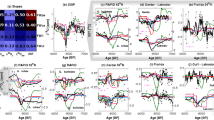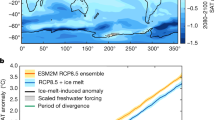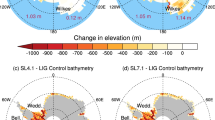Abstract
Previous model experiments of the 8.2 ka event forced by the drainage of Lake Agassiz often do not produce climate anomalies as long as those inferred from proxies. In addition to the Agassiz forcing, there is new evidence for significant amounts of freshwater entering the ocean at 8.2 ka from the disintegration of the Laurentide ice sheet (LIS). We use the Community Climate System Model version 3 (CCSM3) to test the contribution of this additional meltwater flux. Similar to previous model experiments, we find that the estimated freshwater forcing from Lake Agassiz is capable of sustaining ocean and climate anomalies for only two to three decades, much shorter than the event duration of ~150 years in proxies. Using new estimates of the LIS freshwater flux (~0.13 Sv for 100 years) from the collapse of the Hudson Bay ice dome in addition to the Agassiz drainage, the CCSM3 generates climate anomalies with a magnitude and duration that match within error those from proxies. This result is insensitive to the duration of freshwater release, a major uncertainty, if the total volume remains the same. An analysis of the modeled North Atlantic freshwater budget indicates that the Agassiz drainage is rapidly transported out of the North Atlantic while the LIS contribution generates longer-lasting freshwater anomalies that are also subject to recirculation by the subtropical gyre back into the North Atlantic. Thus, the meltwater flux originating from the LIS appears to be more important than the Agassiz drainage in generating 8.2 ka climate anomalies and is one way to reconcile some model-data discrepancies.













Similar content being viewed by others
References
Andersen C, Koç N, Jennings A, Andrews JT (2004a) Nonuniform response of the major surface currents in the Nordic Seas to insolation forcing: implications for the Holocene climate variability. Paleoceanography 19:PA2003. doi:10.1029/2002PA000873
Andersen C, Koç N, Moros M (2004b) A highly unstable Holocene climate in the subpolar North Atlantic: evidence from diatoms. Quat Sci Rev 23:2155–2166
Barber DC, Dyke A, Hillaire-Marcel C, Jennings AE, Andrews JT, Kerwin MW, Bilodeau G, McNeely R, Southon J, Morehead MD, Gagnon J-M (1999) Forcing of the cold event of 8,200 years ago by catastrophic drainage of Laurentide lakes. Nature 400:344–348
Berger AL (1978) Long-term variations of caloric insolation resulting from the Earth’s orbital elements. Quat Res 9:139–167
Bianchi GG, McCave IN (1999) Holocene periodicity in North Atlantic climate and deep-ocean flow south of Iceland. Nature 397:515–517
Boch R, Spotl C, Kramers J (2009) High-resolution isotope records of early Holocene rapid climate change from two coeval stalagmites of Katerloch Cave, Austria. Quat Sci Rev 28:2527–2538
Came RE, Oppo DW, McManus JF (2007) Amplitude and timing of temperature and salinity variability in the subpolar North Atlantic over the past 10 k.y. Geology 35:315–318
Carlson AE, Winsor K (2012) Northern Hemisphere ice-sheet responses to past climate warming. Nat Geosci 5:607–613
Carlson AE, LeGrande AN, Oppo DW, Came RE, Schmidt GA, Anslow FS, Licciardi JM, Obbink EA (2008) Rapid early Holocene deglaciation of the Laurentide ice sheet. Nat Geosci 1:620–624
Carlson AE, Clark PU, Haley BA, Klinkhammer GP (2009) Routing of western Canadian Plains runoff during the 8.2 ka cold event. Geophys Res Lett 36:L14704
Cheng H, Fleitmann D, Edwards RL, Wang X, Cruz FW, Auler AS, Mangini A, Wang Y, Kong X, Burns SJ, Matter A (2009) Timing and structure of the 8.2 kyr B.P. event inferred from d18O records of stalagmites from China, Oman, and Brazil. Geology 37:1007–1010
Clarke GKC, Leverington DW, Teller JT, Dyke AS (2004) Paleohydraulics of the last outburst flood from glacial Lake Agassiz and the 8200 BP cold event. Quat Sci Rev 23:389–407
Clarke GKC, Bush ABG, Bush JWM (2009) Freshwater discharge, sediment transport, and modeled climate impacts of the final drainage of Glacial Lake Agassiz. J Clim 22:2161–2180
Collins WD, Bitz CM, Blackmon ML, Bonan GB, Bretherton CS, Carton JA, Chang P, Doney SC, Hack JJ, Henderson TB, Kiehl JT, Large WG, McKenna DS, Santer BD, Smith RD (2006) The community climate system model version 3 (CCSM3). J Clim 19:2122–2143
Cronin TM, Vogt PR, Willard DA, Thunell R, Halka J, Berke M, Pohlman J (2007) Rapid sea level rise and ice sheet response to 8,200-year climate event. Geophys Res Lett 34:L20603. doi:10.1029/2007GL031318
deVernal A, Hillaire-Marcel C (2006) Provincialism in trends and high frequency changes in the northwest North Atlantic during the Holocene. Glob Planet Change 54:263–290
Dyke AS (2004) An outline of North American deglaciation with emphasis on central and northern Canada. In: Ehlers J, Gibbard PL (eds) Quaternary glaciations: extent and chronology, part II: North America. Elsevier, Amsterdam, pp 373–424
Ellison CRW, Chapman MR, Hall IR (2006) Surface and deep ocean interactions during the cold climate event 8200 years ago. Science 312:1929–1932
Farmer EJ, Chapman MR, Andrews JE (2008) Centennial-scale Holocene North Atlantic surface temperatures from Mg/Ca ratios in Globigerina bulloides. Geochem Geophys Geosyst 9:Q12029. doi:10.1029/2008GC002199
Feurdean A, Klotz S, Mosbrugger V, Wolhfarth B (2008) Pollen-based quantitative reconstructions of Holocene climate variability in NW Romania. Palaeogeogr Palaeoclimatol Palaeoecol 260:494–504
Flückiger J, Monnin E, Stauffer B, Schwander J, Stocker TF, Chappellaz J, Raynaud D, Barnola J-M (2002) High-resolution Holocene N2O ice core record and its relationship with CH4 and CO2. Glob Biogeochem Cycles 16:1010. doi:10.29/2001GB001417
Gregory JM, Dixon KW, Stouffer RJ, Weaver AJ, Driesschaert E, Eby M, Fichefet T, Hasumi H, Hu A, Jungclaus JH, Kamenkovich IV, Levermann A, Montoya M, Murakami S, Nawrath S, Oka A, Sokolov AP, Thorpe RB (2005) A model intercomparison of changes in the Atlantic thermohaline circulation in response to increasing atmospheric CO2 concentration. Geophys Res Lett 32:L12703. doi:10.1029/2005GL023209
Hall IR, Bianchi GG, Evans JR (2004) Centennial to millennial scale Holocene climate-deep water linkage in the North Atlantic. Quat Sci Rev 23:1529–1536
Hall IR, Becker J, Thornalley D, Hemming SR (2010) Holocene variability of North Atlantic deep water: palaeocurrent reconstruction of component water masses close to their source. Paper presented at the 10th International Conference on Paleoceanography, La Jolla, CA
Hillaire-Marcel C, de Vernal A, Bilodeau G, Weaver AJ (2001) Absence of deep-water formation in the Labrador Sea during the last interglacial period. Nature 410:1073–1077
Hillaire-Marcel C, de Vernal A, Piper DJW (2007) Lake Agassiz final drainage event in the northwest North Atlantic. Geophys Res Lett 34:L15601. doi:10.1029/2007GL030396
Hoffman JS, Carlson AE, Winsor K, Klinkhammer GP, LeGrande AN, Andrews JT, Strasser JC (2012) Linking the 8.2 ka event and its freshwater forcing in the Labrador Sea. Geophys Res Lett 39:L18703
Hu A, Otto-Bliesner BL, Meehl GA, Han W, Morrill C, Brady EC, Briegleb B (2008) Response of thermohaline circulation to freshwater forcing under present-day and LGM conditions. J Clim 21:2239–2258
Keigwin LD, Sachs JP, Rosenthal Y, Boyle EA (2005) The 8200 yr BP event in the slope water system, western subpolar North Atlantic. Paleoceanography 20:PA2003. doi:10.1029/2004PA001074
Kim J-H, Meggers H, Rimbu N, Lohmann G, Freudenthal T, Muller PJ, Schneider RR (2007) Impacts of the North Atlantic gyre circulation on Holocene climate off northwest Africa. Geology 35:387–390
Kleiven HF, Kissel C, Laj C, Ninnemann US, Richter TO, Cortijo E (2008) Reduced North Atlantic Deep Water coeval with the Glacial lake Agassiz freshwater outburst. Science 319:60–64
Kobashi T, Severinghaus JP, Brook EJ, Barnola J-M, Grachev AM (2007) Precise timing and characterization of abrupt climate change 8200 years ago from air trapped in polar ice. Quat Sci Rev 26:1212–1222
Large WG, Danabasoglu G (2006) Attribution and impacts of upper-ocean biases in CCSM3. J Clim 19:2325–2346
LeGrande AN, Schmidt GA (2008) Ensemble, water isotope-enabled, coupled general circulation modeling insights into the 8.2 ka event. Paleoceanography 23:PA3207. doi:10.1029/2008PA001610
LeGrande AN, Schmidt GA, Shindell DT, Field CV, Miller RL, Koch DM, Faluvegi G, Hoffmann G (2006) Consistent simulations of multiple proxy responses to an abrupt climate change event. Proc Natl Acad Sci 103:837–842
Levine RC, Bigg GR (2008) Sensitivity of the glacial ocean to Heinrich events from different iceberg sources, as modeled by a coupled atmosphere-iceberg-ocean model. Paleoceanography 23:PA4213. doi:10.1029/2008PA001613
Lewis CFM, Miller AAL, Levac E, Piper DJW, Sonnichsen GV (2012) Lake Agassiz outburst age and routing by Labrador Current and the 8.2 cal ka cold event. Quat Int 260:83–97
Li Y-X, Tornqvist TE, Nevitt JM, Kohl B (2012) Synchronizing a sea-level jump, final Lake Agassiz drainage, and abrupt cooling 8200 years ago. Earth Planet Sci Lett 315–316:41–50
Licciardi JM, Teller JT, Clark PU (1999) Freshwater routing by the Laurentide ice sheet during the last deglaciation. In: Clark PU, Webb RS, Keigwin LD (eds) Mechanisms of global climate change at millennial time scales, vol 112. American Geophysical Union, Washington, pp 177–201
Marchal O, Cacho I, Stocker TF, Grimalt JO, Calvo E, Martrat B, Shackleton NJ, Vautravers M, Cortijo E, van Kreveld S, Andersson C, Koç N, Chapman M, Sbaffi L, Duplessy J-C, Sarnthein M, Turon J-L, Duprat J, Jansen E (2002) Apparent long-term cooling of the sea surface in the northeast Atlantic and Mediterranean during the Holocene. Quat Sci Rev 21:455–483
McManus JF, Francois R, Gherardi J-M, Keigwin LD, Brown-Leger S (2004) Collapse and rapid resumption of Atlantic meridional circulation linked to deglacial climate changes. Nature 428:834–837
Monnin E, Steig EJ, Siegenthaler U, Kawamura K, Schwander J, Stauffer B, Stocker TF, Morse DL, Barnola J-M, Bellier B, Raynaud D, Fischer H (2004) Evidence for substantial accumulation rate variability in Antarctica during the Holocene, through synchronization of CO2 in the Taylor Dome, Dome C and DML ice cores. Earth Planet Sci Lett 224:45–54
Morrill C, Jacobsen RM (2005) How widespread were climate anomalies 8200 years ago? Geophys Res Lett 32:L19701
Oppo DW, McManus JF, Cullen JL (2003) Deepwater variability in the Holocene epoch. Nature 422:277–278
Otto-Bliesner BL, Brady EC, Clauzet G, Tomas R, Levis S, Kothavala Z (2006) Last glacial maximum and Holocene climate in CCSM3. J Clim 19:2526–2544
Peltier WR (2004) Global glacial isostasy and the surface of the ice-age earth: the ICE-5G (VM2) model and GRACE. Ann Rev Earth Planet Sci 32:111–149
Praetorius S, McManus JF, Oppo DW, Curry WB (2008) Episodic reductions in bottom-water currents since the last ice age. Nat Geosci 1:449–452
Renssen H, Goosse H, Fichefet T (2002) Modeling the effect of freshwater pulses on the early Holocene climate: the influence of high-frequency climate variability. Paleoceanography 17:1020. doi:10.1029/2001PA000649
Sarmaja-Korjonen K, Seppä H (2007) Abrupt and consistent responses of aquatic and terrestrial ecosystems to the 8200 cal. yr cold event: a lacustrine record from Lake Arapisto, Finland. Holocene 17:457–467
Schmidt GA, LeGrande AN (2005) The Goldilocks abrupt climate change event. Quat Sci Rev 24:1109–1110
Schmittner A, Latif M, Schneider B (2005) Model projections of the North Atlantic thermohaline circulation for the 21st century assessed by observations. Geophys Res Lett 32:L23710. doi:10.1029/2005GL024368
Solignac S, Giraudeau J, de Vernal A (2006) Holocene sea surface conditions in the western North Atlantic: spatial and temporal heterogeneities. Paleoceanography 21:PA2004. doi:10.1029/2005PA001175
Spence JP, Eby M, Weaver AJ (2008) The sensitivity of the Atlantic meridional overturning circulation to freshwater forcing at eddy permitting resolutions. J Clim 21:2697–2710
Thomas ER, Wolff EW, Mulvaney R, Steffensen JP, Johnsen SJ, Arrowsmith C, White JWC, Vaughn B, Popp T (2007) The 8.2 ka event from Greenland ice cores. Quat Sci Rev 26:70–81
Thornalley DJR, Elderfield H, McCave IN (2009) Holocene oscillations in temperature and salinity of the surface subpolar North Atlantic. Nature 457:711–714
Tindall JC, Valdes PJ (2011) Modeling the 8.2 ka event using a coupled atmosphere-ocean GCM. Glob Planet Change 79:312–321
Tornqvist TE, Bick SJ, Gonzalez JL, van der Borg K, De Jong AFM (2004) Tracking the sea-level signature of the 8.2 ka cooling event: new constraints from the Mississippi Delta. Geophys Res Lett 31:L23309. doi:10.1029/2004GL021429
Veski S, Seppä H, Ojala AEK (2004) Cold event at 8200 yr BP recorded in annually laminated lake sediments in Eastern Europe. Geology 32:681–684
von Grafenstein U, Erlenkeuser H, Brauer A, Jouzel J, Johnsen SJ (1999) A Mid-European decadal isotope-climate record from 15,500 to 5000 years BP. Science 284:1654–1657
Wiersma AP, Jongma JI (2010) A role for icebergs in the 8.2 ka climate event. Clim Dyn 35:535–549
Wiersma AP, Renssen H (2006) Model-data comparison for the 8.2 ka B.P. event: confirmation of a forcing mechanism by catastrophic drainage of Laurentide lakes. Quat Sci Rev 25:63–88
Wiersma AP, Renssen H, Goosse H, Fichefet T (2006) Evaluation of different freshwater forcing scenarios for the 8.2 ka BP event in a coupled climate model. Clim Dyn 27:831–849
Wunsch C (2010) Towards understanding the Paleocean. Quat Sci Rev 29:1960–1967
Acknowledgments
We thank two anonymous reviewers for their helpful comments and suggestions. This research was funded by grants from the National Science Foundation, Office of Polar Programs, to C. M. (ARC-0713951) and B. O.-B. (ARC-0713971) and the NOAA Hollings Scholar Program to K. W. Proxy data was harvested from the World Data Center for Paleoclimatology. This manuscript benefited from insightful conversations with E. Brady, A. Carlson, and Z. Liu. Supercomputer time was provided by a grant from the National Center for Atmospheric Research (NCAR) Computational Information Systems Laboratory (CISL). The National Center for Atmospheric Research is sponsored by the National Science Foundation.
Author information
Authors and Affiliations
Corresponding author
Rights and permissions
About this article
Cite this article
Wagner, A.J., Morrill, C., Otto-Bliesner, B.L. et al. Model support for forcing of the 8.2 ka event by meltwater from the Hudson Bay ice dome. Clim Dyn 41, 2855–2873 (2013). https://doi.org/10.1007/s00382-013-1706-z
Received:
Accepted:
Published:
Issue Date:
DOI: https://doi.org/10.1007/s00382-013-1706-z




